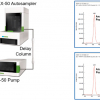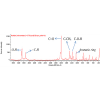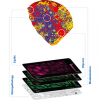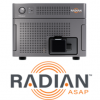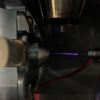Judy Stone
Center for Advanced Laboratory Medicine, University of California San Diego, USA. E-mail: [email protected]
Liquid chromatography-tandem mass spectrometry (LC-MS/MS) is a powerful technique for the quantification of small molecules in body fluids, but some sample preparation is necessary prior to analysis. With so many options available, choosing the right sample clean-up method can be bewildering for novice users. A basic understanding of the principles of sample preparation—combined with a structured approach to selecting, optimising and validating a protocol—can pay dividends in terms of time saved and more accurate and robust LC-MS/MS assays. This article looks at the key factors to consider when selecting an LC-MS/MS sample preparation strategy, outlining the principal processing methods and providing practical advice on protocol development using quantification of serum testosterone in serum samples as the model compound.
Introduction
Liquid chromatography-tandem mass spectrometry (LC-MS/MS) is a well-established tool for the identification and quantification of small molecules in research and industrial settings, but the technique has only recently moved into the healthcare arena. Historically, the implementation challenge for clinical research laboratories has been the development of reliable, reproducible and cost-effective sample preparation methods but, thanks to recent technology breakthroughs, LC-MS/MS is rapidly becoming the technique of choice for many small molecule testing applications.
Why is sample preparation needed?
Small molecule analysis can be performed on a variety of sample types in a clinical research setting—including whole blood, serum, plasma, urine and cerebrospinal fluid (CSF)—and there are three main reasons that samples may need processing prior to LC-MS/MS. The most straightforward of these is to remove proteins and other constituents that may precipitate when injected into the LC mobile phase, to avoid clogging the chromatography column. Depleting or removing these matrix components prevents damage to the column and the build-up of excessive pressure within the LC system.
The next reason is to improve chromatographic performance. The volume, pH, organic solvent, buffer and aqueous composition of the liquid injected into the LC have a profound effect on chromatography, modifying LC peak shapes, peak separation and retention times (Rt). These can influence the quantitation limits, selectivity and robustness of the assay. To overcome these issues, complex biofluids often need to be exchanged for an injection solution compatible with the LC method prior to injection.
Finally, the precision and accuracy of the method, as well as the long-term stability of the LC-MS/MS instrument response, is almost always improved by selectively depleting the biological matrix to increase the analyte-to-matrix ratio. For example, phospholipids are a major constituent of cell membranes, present in serum in mg mL–1 amounts, which can significantly affect method performance unless depleted during sample preparation. This type of “matrix effect” is a major constraint of LC-MS/MS methods, and is discussed further in the Assay quality section below.
What are the options of sample preparation?
In the ideal world, sample preparation should be simple, low cost and allow matrix depletion with the option to concentrate the analyte(s) of interest. The most commonly used techniques for small molecule LC-MS/MS sample preparation can be broadly divided into eight categories, each of which is briefly outlined below and summarised in Table 1.
Table 1. Overview of LC-MS/MS sample preparation protocols.
Protocol | Analyte | Relative cost | Relative complexity | Relative matrix depletion |
Dilution | No | Low | Simple | Less |
Protein precipitation | No | Low | Simple | Least |
Phospholipid removal | No | High | Relatively simple | Moreb |
Liquid-liquid extraction | Yes | Low | Complex | More |
Supported-liquid extraction | Yes | High | Moderately complex | More |
AC Extraction Plate | Yes | High | Relatively simple | More |
Solid-phase extraction | Yes | High | Complex | More |
Online SPE | Yes | High | Complex | More |
awithout matrix concentration, bphospholipids and precipitated proteins are removed, but not other matrix components
Dilution
Dilution or “dilute and shoot” methods simply involve the addition of purified water or the LC mobile phase to the patient sample prior to LC-MS/MS analysis. This technique is widely used for low protein matrices (e.g. urine or CSF) because it is fast, simple and inexpensive. Ideally, the sample, internal standard and diluent are pipetted directly into the autosampler vial or microplate well, then mixed, centrifuged and loaded straight onto the LC-MS/MS for automated analysis. This ensures a streamlined workflow and minimises resource and reagent use.
Protein precipitation (PPT)
Protein precipitation or “protein crash” is analogous to dilution methods, but is intended for high protein matrices, such as serum, plasma or whole blood. PPT has many of the same features that make dilution a popular sample preparation protocol, being fast, simple and cheap. The sample, internal standard and a precipitating agent, such as acetonitrile or methanol/ZnSO4, are mixed together, then centrifuged or filtered to separate out the precipitated proteins before the supernatant is injected into the LC-MS/MS system.1
Liquid–liquid extraction (LLE)
Liquid–liquid extraction has been used in sample preparation workflows for many years, and involves the partitioning of analyte(s) from an aqueous biofluid into a water immiscible organic solvent based on polarity. It offers a number of benefits for LC-MS/MS assays, as it allows the concentration of analytes, enhancing sensitivity, and depletion of matrix components, increasing selectivity. Unfortunately, this multi-step process is relatively labour intensive, requiring the partitioning of the analyte(s) into the organic solvent, separation of the organic and aqueous layers, evaporation of the organic solvent, and reconstitution of the analyte(s) in a solvent mixture that is miscible with the LC mobile phase.
Phospholipid removal media (PLR)
Although 96-well format plates for filtering protein precipitates have been available commercially for many years, the last decade has seen the development of filtration plates designed to capture and remove phospholipids. The post-precipitation supernatant flows through a bed packed with moieties, e.g. zirconia-coated silica, that retain phospholipids. This offers greater selectivity while maintaining the simplicity of PPT protocols.2
Supported or solid-supported liquid extraction (SLE)
Supported liquid extraction is similar to LLE, but the partitioning of analytes from the aqueous biofluid into an immiscible organic solvent occurs in a particulate bed, composed of diatomaceous earth or synthetic particles, packed into a cartridge or 96-well plate. The diluted biofluid is slowly added to the bed and becomes dispersed in an ultra-thin layer coating the particles. An immiscible organic solvent is then passed through the media, causing high efficiency partitioning of non-polar analytes into the solvent. This method offers many of the sensitivity/selectivity advantages of LLE,3 while being less labour intensive and resulting in more consistent extraction.
Solid-phase extraction (SPE)
Solid-phase extraction uses a selective stationary phase which binds or partitions the analyte(s). This phase often requires pre-treatment for optimal extraction, then the diluted biofluid flows through the stationary phase, which captures the analyte(s) while allowing other matrix components to flow to waste. Following several wash steps, an elution solvent is used to recover the analyte(s). Samples may then require eluate evaporation and reconstitution with an LC-MS/MS compatible solvent before analysis.
AC Extraction Plate™ (ACP)
The AC Extraction Plate† (Tecan) is a “smart” extraction consumable that works on the same principles as SLE, partitioning non-polar analytes from aqueous biofluids into a more non-polar phase. The difference is that the ACP uses a proprietary polymer, which is coated onto the plate wells, as the stationary phase. The advantage of this approach is that it uses a “pipette and shake” protocol: the analyte is partitioned into the non-polar stationary phase, the extraction residue is discarded. Then, following a wash step, a relatively non-polar elution reagent is used to partition the analyte(s) back into the liquid phase. By eliminating the flow-through process used in most SLE or SPE protocols, the ACP workflow is easily automated. It also has the capacity to concentrate analytes and deplete matrix components, leading to enhanced specificity and sensitivity.4
Online SPE (O-SPE)
Online SPE uses an LC “trap” column—analogous to the SPE cartridge or plate—to capture the analyte while matrix components flow to waste. Reversal of the flow then elutes the target analyte(s) directly onto the analytical LC column. This approach minimises hands-on time, but requires a more sophisticated LC set-up and a high level of expertise to ensure consistent performance.
Why invest in additional sample clean-up?
Table 1 clearly indicates that dilution and PPT are the most straightforward and inexpensive sample preparation techniques, although greater complexity and/or increased costs are necessary to selectively concentrate analytes and deplete matrix components. The value of analyte concentration seems obvious—increasing sensitivity—but what are the benefits of matrix depletion? There are two main reasons to perform enhanced sample clean-up; improving assay quality and enhancing process reliability.
Assay quality
Atmospheric pressure ionisation (API) is the chemical process that converts uncharged analytes in a liquid phase to ions in the gas phase to allow detection by MS. It is well established that the presence of residual matrix components in the LC eluate causes interference with the ionisation process within an API source. This “matrix effect” differs between samples and analytes, potentially causing quantification errors.
As mentioned previously, phospholipids are a major source of unacceptable matrix effects in serum, plasma and whole blood samples. Co-eluting a stable-isotope labelled internal standard (SIL-IS) can be used to effectively compensate for matrix effects, but consensus guidelines and accreditation requirements for clinical research laboratories often require detailed evaluation of these matrix effects during method validation.5–9 For example, the College of American Pathologists’ checklist5 states that the average matrix effect determined from at least 10 different matrix sources must be less than 25 %, and the coefficient of variation (relative standard deviation) due to matrix effects must be less than 15 %, or “validation studies must include data to demonstrate that matrix effects do not affect assay accuracy”. As a result, a sample preparation protocol that efficiently depletes matrix components will be necessary for many assays.
Robust operations
Another reason for depleting matrix components during sample preparation is to preserve the cleanliness and, therefore, performance of the mass spectrometer. Each injection of an extracted biological sample deposits some residual matrix material on the hardware of the mass spectrometer, and these deposits gradually degrade the handling of ions. Over time, this will result in fewer ions reaching the detector, reducing sensitivity until the instrument fails system suitability testing and must be cleaned. Each cleaning cycle (venting to atmospheric pressure, cleaning the hardware and pumping back down to high vacuum) can take up to 24 hours, resulting in a significant loss of instrument time. Cleaner extracts can help to lengthen maintenance-free intervals, leading to more uptime and greater productivity.
Effective pre-analytical sample clean-up can also make the need for instrument maintenance and servicing more predictable, ideally limiting servicing to scheduled six-month preventive maintenance visits. Compared with a sudden, unexpected loss of sensitivity due to insufficient sample preparation, this avoids batch failures and unplanned downtime, which have the knock-on effects of more sample repeats, turnaround time delays and higher production costs.
It is also worth remembering that the mass spectrometer is not the only component of your system that may be degraded by the presence of residual matrix materials. Excessive pressure due to clogging of injection valves, tubing, guard columns and columns can cause an LC system to shut down without completing a run, leading to more repeat testing and delays. Investment in additional sample clean-up can also help to extend the operational life of guard columns and columns, while enhancing chromatographic performance.
How to choose a sample preparation technique?
There is no one size fits all solution for LC-MS/MS sample preparation. When selecting the most appropriate technique for your assay and workflow, consider these factors:
- Analyte chemistry: polarity (Log P, Log D), charge (pKa), thermal stability and molecular weight.
- Analyte concentration: is concentration or dilution of the analyte(s) needed to achieve the desired lower limit of quantitation (LLoQ)?
- Known challenges: specific applications have widely recognised difficulties, such as achieving appropriate sensitivity for serum steroid hormones, sufficient selectivity for opiates/metabolites in urine, or a robust protocol for high throughput tests such as serum 25-hydroxy vitamin D.
- Workload: sample volume constraints, batch size expectations, and throughput and turnaround time requirements.
- Laboratory resources: automated versus manual liquid handling, experience with LC multiplexing and O-SPE automation, availability of extraction equipment (solvent evaporators, positive pressure or vacuum extraction modules, heating blocks, multi-vortexers etc.), expertise available for sample preparation during development, validation and production.
To demonstrate how a systematic approach can be applied in practice, consider the selection of an extraction protocol for serum testosterone. A recent publication details the use of ACP to develop a serum testosterone analysis suitable for specimens from women and infants.4 The laboratory’s key considerations for the new workflow were good precision, better selectivity than automated immunoassays and ease of automation.
- Testosterone is a thermally stable, non-polar, neutral steroid (Log P = 3.32) with molecular weight of 288.42. Extraction protocols that work particularly well with neutral non-polar small molecules are LLE, SLE and ACP. PPT, SPE and O-SPE are also options, but with some caveats. Mixed mode SPE (combining reverse phase and ion exchange stationary phases) is highly selective for weak acids and weak bases, because both polarity and charge can be used for analyte retention/matrix removal. In contrast, retaining an uncharged analyte such as testosterone on a simple non-polar C18 stationary phase, while simultaneously attempting to remove non-polar matrix constituents, is more challenging.
- (2 & 3) Much lower quantification limits are required when measuring testosterone in paediatric and female patients compared to adult males. A challenging LLoQ of 1–5 ng dL–1 is desirable, and typically requires concentration. Dilution and PLR protocols do not concentrate analytes, and dilution does not remove serum proteins. PPT protocols involve dilution and, if evaporated after the precipitation step, will concentrate matrix components as well as the analyte, making it more difficult to maintain an appropriate LLoQ. LLE, SLE, ACP, SPE and O-SPE are more appropriate, with some theoretical preference for LLE, SLE and ACP.
- LLE has the lowest cost of materials, and works well for small batches, but requires excellent manual technique, is too labour intensive for large workloads and can be difficult to automate. O-SPE requires minimal hands-on time, but in-house expertise is needed to maintain a high throughput O-SPE set-up. SLE, ACP and SPE are all well-suited to high throughput applications and automated liquid handling in 96-well plates. Comparing ease of automation, ACP uses less equipment (only an orbital shaker) and does not require a positive pressure or vacuum manifold, while SLE has fewer steps than SPE.
- Resources and available expertise are usually the decisive factors. For laboratories with access to in-house or external expertise, personal preference, prior experience and availability of extraction and automated liquid handling equipment will all come into play. As a result, there are diagnostic laboratories using LLE, SLE, SPE, O-SPE (as well as the most recent option, ACP) for testosterone analysis. For those developing their expertise in-house, there is extensive literature for LLE10–13 and vendors of SLE, SPE, O-SPE and ACP consumables offer extensive application support. ACP and SLE would be the easiest techniques to automate for most laboratories.
Following this process, ACP was chosen as the preferred sample preparation technique, due to the technology’s potential to reduce variability and improve batch-to-batch stability through optimisation of the extraction protocol. The resulting, extensively validated method has yielded excellent precision, accuracy and robustness.4
Summary
Sample preparation is a “necessary evil” for sensitive and reproducible LC-MS/MS analysis, and also offers operational benefits in terms of instrument uptime and maintenance scheduling. Many clinical research laboratories are now looking to take advantage of LC-MS/MS for small molecule quantification, but each lab must choose which sample clean-up technique is most appropriate to its analytical goals and workload.
For the serum testosterone example discussed, the ACP method chosen provided a combination of good sensitivity and precision, improved selectivity over existing immunoassay methods and ease of automation.4 The availability of newly developed extraction consumables, such as the AC Extraction Plate, provide innovative and cost-effective alternatives to traditional liquid- or solid-phase techniques, offering laboratories the potential to improve assay performance and reliability while reducing the burden on busy laboratory staff.14
References and note
- C. Polson, P. Sarkar, B. Incledon, V. Raguvaran and R. Grant, “Optimization of protein precipitation based upon effectiveness of protein removal and ionization effect in liquid chromatography-tandem mass spectrometry”, J. Chromatogr. B 785, 263–275 (2003). doi: https://doi.org/10.1016/S1570-0232(02)00914-5
- J. Carmichael and S. Brown, “The impact of phospholipids and phospholipid removal on bioanalytical method performance”, Biomed. Chromatogr. 30, 710–720 (2016). doi: https://doi.org/10.1002/bmc.3686
- R.E. Majors, “Supported liquid extraction: the best-kept secret in sample preparation”, LCGC Europe 25, 430–435 (2012).
- J.A. Stone, D.R. van Staveren and R.L. Fitzgerald, “Automated sample preparation enables LC-MS/MS as a routine diagnostic analysis for serum testosterone”, J. Appl. Lab. Med. 2, 33–46 (2017). doi: https://doi.org/10.1373/jalm.2016.022772
- College of American Pathologists [CAP] Chemistry and Toxicology Accreditation Checklist (2016). https://www.cap.org/laboratory-improvement/accreditation/accreditation-checklists
- European Medicines Agency Guideline on Bioanalytical Method Validation (2012). http://www.ema.europa.eu/docs/en_GB/document_library/Scientific_guideline/2011/08/WC500109686.pdf
- US FDA Guidance for Industry, Bioanalytical Method Validation (2015 & 2018). https://www.fda.gov/downloads/drugs/guidances/ucm386366.pdf and https://www.fda.gov/downloads/drugs/guidances/ucm070107.pdf
- Scientific Working Group for Forensic Toxicology [SWGTOX] Standard Practices for Method Validation in Forensic Toxicology (2013). https://academic.oup.com/jat/article/37/7/452/765476
- CLSI, Liquid Chromatography-Mass Spectrometry Methods; Approved Guideline. CLSI document C62-A. Clinical and Laboratory Standards Institute, Wayne, PA, USA (2014).
- D. French, “Development and validation of a serum total testosterone liquid chromatography-tandem mass spectrometry (LC-MS/MS) assay calibrated to NIST SRM 971”, Clin. Chim. Acta 415, 109–117 (2013). doi: https://doi.org/10.1016/j.cca.2012.10.007
- U. Turpeinen, S. Linko, O. Itkonen and E. Hämäläinen, “Determination of testosterone in serum by liquid chromatography-tandem mass spectrometry”, Scand. J. Clin. Lab. Invest. 68, 50–57 (2008). doi: https://doi.org/10.1080/00365510701496496
- Y. Wang, G.D. Gay, J.C. Botelho, S.P. Caudill and H.W. Vesper, “Total testosterone quantitative measurement in serum by LC-MS/MS”, Clin. Chim. Acta 436, 263–267 (2014). doi: https://doi.org/10.1016/j.cca.2014.06.009
- S.X. Peng, T.M. Branch and S.L. King, “Fully automated 96-well liquid-liquid extraction for analysis of biological samples by liquid chromatography with tandem mass spectrometry”, Anal. Chem. 73, 708–714 (2001). doi: https://doi.org/10.1021/ac001036c
- For more information on the applications discussed here, contact [email protected].
†For research only. Not for use in diagnostic procedures.

Judy Stone, Ph.D., MT(ASCP), DABCC
Judy Stone obtained her Ph.D. at the University of Toronto, and has been working with clinical chromatography and mass spectrometry since 1984. Her research interests are in mass spectrometry method development and automation for clinical toxicology, TDM, and endocrinology. She teaches a short course twice yearly on “Getting started with quantitative clinical LC-MS/MS” at MSACL meetings in the United States and Europe, and was the faculty chair for the AACC online certificate course (1st edition) in clinical mass spectrometry.




